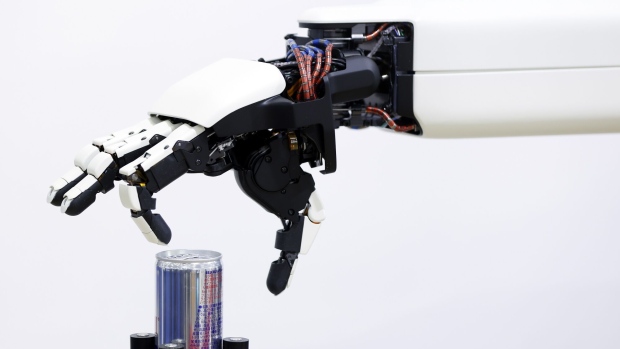Mar 12, 2024
Physical Intelligence Is Building a Brain for Robots
, Bloomberg News

(Bloomberg) -- Since the earliest sci-fi books and films, computers imbued with artificial intelligence have almost always been accompanied by equally clever moving machines, like androids and other robots. Over the past 15 years or so, however, AI systems that work entirely in software have grown far more sophisticated than their moving counterparts. Robots can build cars in factories and clean up after us at home but are able to carry out a relatively small range of tasks compared to the increasingly general nature of chatbots.
A startup called Physical Intelligence has set out to alter this situation. Formed this year by a team of robotics and AI experts, the company plans to create software that can add high-level intelligence to a wide variety of robots and machines. Or, as co-founder and Chief Executive Officer Karol Hausman puts it in Physical Intelligence’s first public interview since founding the company: “We aim to bring AI to the physical world with a universal model that can power any robot or any physical device basically for any application.”
The rise of the language processing AI built by OpenAI, Google and others have been made possible by the huge volume of text available on the internet and in other archives. Companies can train their AI models by feeding them billions of examples of how humans use words, a process that has helped computers to mathematically “solve” language. Gathering similar amounts of data from the physical world has proved far more challenging, limiting the progress of AI in the robotics field.
Physical Intelligence’s thesis is that the time is right for a new approach to building robotics AI models. The company looks to merge the techniques used to build language models with its own techniques for controlling and instructing machines. The end goal would be to create an AI that works as a type of general purpose robotics system.
Hausman spent the last few years as a scientist working on robotics at Google. His fellow co-founders include Sergey Levine, who has done pioneering robotics work as a professor at the University of California, Berkeley; Chelsea Finn, a professor at Stanford University; Brian Ichter, a former Google research scientist; and Lachy Groom, a former executive at the payments company Stripe and prominent tech investor. Their company has raised $70 million from Thrive Capital, OpenAI, Sequoia Capital, Greenoaks Capital Partners, Lux Capital and Khosla Ventures, according to a person familiar with their investors who was not authorized to speak publicly about the investment.
Efforts to improve the software that powers robots have been going on for decades. Notably, a company called Willow Garage, formed in 2006, spent several years trying to build a type of general purpose software that could be shared across robots and give them a unified set of basic functions. While its software was picked up by a number of companies and robotics developers, Willow Garage’s work did not lead to a huge a leap forward in robotic intelligence, and the company wound down its operations in 2014.
Other companies like Rethink Robotics tried to build systems that could learn to do jobs by copying movements shown to them by humans. A number of startups have recently implemented AI that uses repetition to teach robotic arms to pick up objects and perform tasks similar to those done by humans in warehouses. Others have begun building androids designed to mimic human movements. One of these startups, Figure AI Inc., just raised $675 million from OpenAI, Nvidia, Jeff Bezos and Microsoft to help it build robots to work in logistics and manufacturing facilities.
Instead of focusing on specific types of robotic arms or industrial androids, Physical Intelligence wants to develop software that can be applied across many types of robotics. To do this, it has set to work creating its own AI model designed to bring basic human abilities to machines. “I think it’s really cool what people are building with humanoids,” Groom says. “But what fundamentally makes humans interesting is the brain, not our hardware. We are the ultimate generalists.”
Over the past few years, researchers have published a string of papers that show how robots are already gaining new levels of intelligence from language and image AI models. If, for example, you tell a robotic arm to tie a shoe, it can use AI to find the basic concepts of a shoe and shoe laces and information about what tying a shoe usually entails. While this is a good start, the robotics hardware still needs some level of training to actually accomplish physical tasks. This has been a major challenge, because having robots perform tasks enough times to learn each new job is time-consuming and costly.
Physical Intelligence has yet to reveal exactly how it plans to overcome this problem. The company’s co-founders say they will not build their own hardware but rather purchase a variety of different robots and train their AI models on that hardware. The objective is to amass the largest body of robotics data created to date, according to the company.
Physical Intelligence faces competition from companies like Figure AI and Tesla Inc. that are making androids, as well as other companies working on general purpose robotics software. Earlier this week, for example, the seven-year-old startup Covariant said that it too has been developing a new type of robotics model that plays off the language, image and video AI advances to improve the abilities of its robotic arms.
The co-founders of Physical Intelligence maintain that they’ve been working through the challenges of AI for robotics for years and have developed novel approaches to issues that have slowed others in the field. “Realistically, I think we are going to need a long and very serious research effort to make this happen,” says Levine. “But there are enough signs that the biggest obstacles to use robots in the real world are now solvable.”
©2024 Bloomberg L.P.





